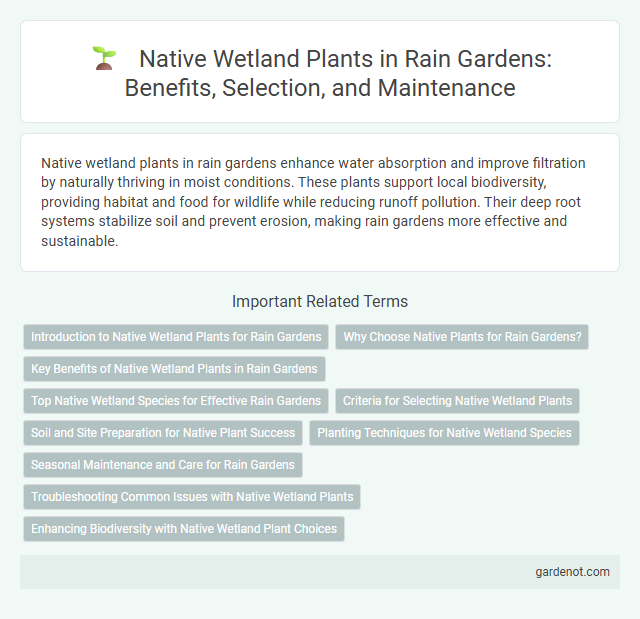Native wetland plants in rain gardens enhance water absorption and improve filtration by naturally thriving in moist conditions. These plants support local biodiversity, providing habitat and food for wildlife while reducing runoff pollution. Their deep root systems stabilize soil and prevent erosion, making rain gardens more effective and sustainable.
Introduction to Native Wetland Plants for Rain Gardens
Native wetland plants are essential for rain gardens due to their ability to thrive in saturated soil conditions while efficiently filtering stormwater runoff. Species such as Carex spp. (sedges), Juncus spp. (rushes), and Lobelia cardinalis (cardinal flower) provide excellent erosion control, habitat for wildlife, and nutrient uptake. Incorporating these native plants enhances rain garden resilience, biodiversity, and water quality in urban landscapes.
Why Choose Native Plants for Rain Gardens?
Native wetland plants are ideal for rain gardens because they are naturally adapted to local soil, water, and climate conditions, ensuring robust growth and resilience. Their deep root systems improve soil infiltration and reduce runoff, enhancing water quality by filtering pollutants. Choosing native species also supports local biodiversity by providing habitat and food sources for indigenous wildlife.
Key Benefits of Native Wetland Plants in Rain Gardens
Native wetland plants in rain gardens enhance water filtration by naturally absorbing pollutants and excess nutrients, improving groundwater quality. Their deep root systems stabilize soil, reducing erosion and promoting better water infiltration to prevent runoff. These plants provide vital habitat for local wildlife, supporting biodiversity and creating a balanced ecosystem.
Top Native Wetland Species for Effective Rain Gardens
Top native wetland species for effective rain gardens include Carex stricta (tussock sedge), Juncus effusus (common rush), and Asclepias incarnata (swamp milkweed), which excel at water filtration and soil stabilization. These plants thrive in saturated soils, increase biodiversity, and provide critical habitat for pollinators and amphibians. Selecting diverse native wetland species enhances rain garden resilience and improves stormwater management outcomes.
Criteria for Selecting Native Wetland Plants
Native wetland plants are selected based on their ability to thrive in saturated soil conditions and contribute to water filtration and erosion control. Key criteria include tolerance to periodic flooding, root structure adaptability for soil stabilization, and compatibility with local hydrology and biodiversity. Choosing species native to the specific region ensures ecological balance and supports wildlife habitats within rain gardens.
Soil and Site Preparation for Native Plant Success
Preparing soil and site conditions is essential for the success of native wetland plants in rain gardens, as these species require well-drained yet moisture-retentive substrates. Proper soil amendment typically involves incorporating organic matter and ensuring a balanced texture that mimics natural wetland environments to support root development and microbial activity. Selecting planting sites with appropriate hydrology and sunlight exposure enhances native plant establishment and long-term ecological function.
Planting Techniques for Native Wetland Species
Planting native wetland species in rain gardens requires thorough soil preparation to mimic natural wetland conditions, including creating anaerobic zones for optimal root growth. Use locally sourced plants with deep, fibrous root systems that enhance water filtration and provide erosion control. Strategic spacing and layering of emergent, marginal, and submerged plants ensure biodiversity and improve the garden's ability to manage stormwater effectively.
Seasonal Maintenance and Care for Rain Gardens
Native wetland plants in rain gardens require seasonal maintenance to ensure optimal growth and filtration efficiency. During spring, remove accumulated debris and prune dead stems to promote healthy new growth, while summer care includes regular watering and monitoring for invasive species to prevent competition. In fall, cut back perennials and mulch the area to protect root systems through winter, enhancing the garden's resilience and functionality in stormwater management.
Troubleshooting Common Issues with Native Wetland Plants
Native wetland plants in rain gardens often face challenges such as improper drainage, soil compaction, and inadequate sunlight, which can hinder their growth and ecological function. Ensuring proper water infiltration and selecting species adapted to site-specific hydrological conditions helps mitigate issues like root rot and nutrient deficiencies. Regular monitoring and amending soil conditions with organic matter supports healthy root development and enhances plant resilience against pests and diseases.
Enhancing Biodiversity with Native Wetland Plant Choices
Native wetland plants such as pickerelweed (Pontederia cordata), blue flag iris (Iris versicolor), and swamp milkweed (Asclepias incarnata) play a crucial role in enhancing biodiversity within rain gardens. These species provide essential habitat and food sources for pollinators, amphibians, and aquatic invertebrates, fostering a balanced ecosystem. Selecting regionally adapted wetland plants ensures better growth, water filtration, and supports local wildlife populations effectively.
Native wetland plant Infographic

 gardenot.com
gardenot.com